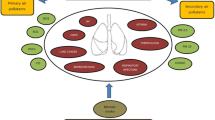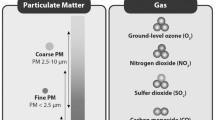Abstract
Diabetics may be more vulnerable to the harmful effects of ambient air pollutants than healthy individuals. But, the risk factors that lead to susceptibility to air pollution in diabetics have not yet been identified. We examined the effect of exposure to ambient PM10 on chronic symptoms and the pulmonary function tests (PFT) in diabetic and non-diabetic subjects. Also, to investigate possible determinants of susceptibility, we recruited 400 type 2 diabetic and 465 healthy subjects who were investigated for chronic respiratory symptoms (CRSs) and then underwent measurement of forced vital capacity (FVC) and forced expiratory volume 1 (FEV1) according to standard protocol. Percent predicted FEV1 and FVC (FEV1% and FVC%, respectively) for each subject were calculated. Particulate matter (PM10) concentrations at residence place of subjects were estimated using AERMOD dispersion model. The association between PM10 and CRSs was explored using logistic regression. We also used linear regression models controlling for potential confounders to study the association between chronic exposure to PM10 and FEV1% and FVC%. Prevalence of current wheezing, allergy symptom, chest tightness, FEV1/FVC <70%, and physician-diagnosed asthma and COPD was significantly higher among diabetic subjects than non-diabetics. There was no significant difference between percent predicted value of PFT among diabetic and non-diabetic subjects (P < 0.05). We estimated that 1 SD increase in PM10 concentration was associated with a greater risk of having dyspnea by 1.50-fold (95% CI, 1.12–2.01). Higher exposure to PM10 concentration was also significantly associated with lower FVC%. The size of effect for 1 SD μg/m3 (=98.38) increase in PM10 concentration was 3.71% (95% CI, 0.48–4.99) decrease in FVC%. In addition, we indicated that strength of these associations was higher in overweight, smoker, and aged persons. We demonstrated a possible contribution of air pollution to reduced lung function independent of diabetes status. This study suggests that decline in exposure may significantly reduce disease manifestation as dyspnea and impaired lung function. We conduct that higher BMI, smoking, and older age were associated with higher levels of air pollution effects.


Similar content being viewed by others
References
Abbey DE, Burchette RJ, Knutsen SF, McDonnell WF, Lebowitz MD, Enright PL (1998) Long-term particulate and other air pollutants and lung function in nonsmokers. Am J Respir Crit Care Med 158(1):289–298
Ackermann-Liebrich U, Leuenberger P, Schwartz J, Schindler C, Monn C, Bolognini G et al (1997) Lung function and long term exposure to air pollutants in Switzerland. Study on Air Pollution and Lung Diseases in Adults (SAPALDIA) Team. Am J Respir Crit Care Med 155(1):122–129. doi:10.1164/ajrccm.155.1.9001300
Alexeeff SE, Litonjua AA, Suh H, Sparrow D, Vokonas PS, Schwartz J (2007) Ozone exposure and lung function: effect modified by obesity and airways hyperresponsiveness in the VA normative aging study. Chest 132(6):1890–1897. doi:10.1378/chest.07-1126
Berend N (2016) Contribution of air pollution to COPD and small airway dysfunction. Respirology 21(2):237–244. doi:10.1111/resp.12644
Brashier B, Londhe J, Madas S, Vincent V, Salvi S (2012) Prevalence of self-reported respiratory symptoms, asthma and chronic bronchitis in slum area of a rapidly developing Indian city. Open J Respir Dis 2(03):73
Chestnut LG, Schwartz J, Savitz DA, Burchfiel CM (1991) Pulmonary function and ambient particulate matter: epidemiological evidence from NHANES I. Arch Environ Health 46(3):135–144. doi:10.1080/00039896.1991.9937440
Chung KF (2001) Cytokines in chronic obstructive pulmonary disease. Eur Respir J 18(34 suppl):50s–59s. doi:10.1183/09031936.01.00229701
Cimorelli, A. J., Perry, S. G., Venkatram, A., Weil, J. C., Paine, R. J., & Peters, W. D. (1998). AERMOD–description of model formulation.
CPCB (2011) Air quality monitoring, emission inventory and source apportionment studies for Indian cities. Retrieved Jan 2011 from http://cpcb.nic.in/Source_Apportionment_Studies.php
Ebi-Kryston KL, Hawthorne VM, Rose G, Shipley MJ, Gillis CR, Hole DJ et al (1989) Breathlessness, chronic bronchitis and reduced pulmonary function as predictors of cardiovascular disease mortality among men in England, Scotland and the United States. Int J Epidemiol 18(1):84–88
Forbes LJ, Kapetanakis V, Rudnicka AR, Cook DG, Bush T, Stedman JR et al (2009) Chronic exposure to outdoor air pollution and lung function in adults. Thorax 64(8):657–663. doi:10.1136/thx.2008.109389
Gaffneya P, MacDonaldb T, Benjaminc M, Cored J, & Ojhae A (2007) India PM10 emission inventory training and capacity building programs: EPA efforts for developing a sustainable foundation. California: Envirnonment Protection Agency.
Ghanavati T, Shaterzadeh Yazdi MJ, Goharpey S, Arastoo AA (2012) Functional balance in elderly with diabetic neuropathy. Diabetes Res Clin Pract 96(1):24–28. doi:10.1016/j.diabres.2011.10.041
Glaser S, Kruger S, Merkel M, Bramlage P, Herth FJ (2015) Chronic obstructive pulmonary disease and diabetes mellitus: a systematic review of the literature. Respiration 89(3):253–264. doi:10.1159/000369863
Gomez-Mejiba SE, Zhai Z, Akram H, Pye QN, Hensley K, Kurien BT et al (2009) Inhalation of environmental stressors & chronic inflammation: autoimmunity and neurodegeneration. Mutat Res 674(1–2):62–72. doi:10.1016/j.mrgentox.2008.09.016
Götschi T, Sunyer J, Chinn S, de Marco R, Forsberg B, Gauderman JW et al (2008) Air pollution and lung function in the European Community Respiratory Health Survey. Int J Epidemiol 37(6):1349–1358
Gregg EW, Sattar N, Ali MK (2016) The changing face of diabetes complications. Lancet Diabetes Endocrinol 4(6):537–547. doi:10.1016/S2213-8587(16)30010-9
Happo MS, Salonen RO, Halinen AI, Jalava PI, Pennanen AS, Dormans JA et al (2010) Inflammation and tissue damage in mouse lung by single and repeated dosing of urban air coarse and fine particles collected from six European cities. Inhal Toxicol 22(5):402–416. doi:10.3109/08958370903527908
Kamat S, Doshi V (1987) Sequential health effect study in relation to air pollution in Bombay, India. Eur J Epidemiol 3(3):265–277
Kesavachandran C, Pangtey B, Bihari V, Fareed M, Pathak M, Srivastava A, Mathur N (2013) Particulate matter concentration in ambient air and its effects on lung functions among residents in the National Capital Region, India. Environ Monit Assess 185(2):1265–1272
Khafaie MA, Salvi SS, Ojha A, Khafaie B, Gore SD, Yajnik CS (2013) Systemic inflammation (C-reactive protein) in type 2 diabetic patients is associated with ambient air pollution in Pune City, India. Diabetes Care 36(3):625–630. doi:10.2337/dc12-0388
Khafaie MA, Yajnik C, Mojadam M, Khafaie B, Salvi SS, Ojha A, Gore SS (2016) Association between ambient temperature and blood biomarker of systemic inflammation in (C-reactive protien) in diabetes patients. Arch Med 8:3
Khafaie MA, Yajnik CS, Salvi SS, Ojha A, Khafaie B, & Gore SD (2017) Particulate matter and markers of glycemic control, insulin resistance and β-cell function in type 2 diabetic patients: result from Wellcome Trust Genetic study. Manuscript submitted for publication.
Lancet (2016) Beat diabetes: an urgent call for global action. Lancet 387(10027):1483. doi:10.1016/S0140-6736(16)30185-4
Leuenberger P (1995) Air pollution in Switzerland and respiratory diseases in adults. Results of a preliminary study of the cross-sectional part of the Sapaldia study. Praxis (Bern 1994) 84(40):1096–1100
Li N, Wang M, Oberley TD, Sempf JM, Nel AE (2002) Comparison of the pro-oxidative and proinflammatory effects of organic diesel exhaust particle chemicals in bronchial epithelial cells and macrophages. J Immunol 169(8):4531–4541
López-Campos JL, Ruiz-Ramos M, Soriano JB (2014) Mortality trends in chronic obstructive pulmonary disease in Europe, 1994–2010: a joinpoint regression analysis. Lancet Respir Med 2(1):54–62 doi: http://dx.doi.org/10.1016/S2213-2600(13)70232-7
Nicole W (2015) Air pollution and diabetes risk: assessing the evidence to date. Environ Health Perspect 123(5):A134. doi:10.1289/ehp.123-A134
Ojha A, Kumar R, Boralkar D, Gargava P, Gaffeney P, Benjamin M, & Mukkannawar U (2006) Continual improvement of emission estimates–the Pune experience (2004 to 2006). Paper presented at the Better Air Quality 2006, Yogyakarta, Indonesia.
O’Neill MS, Veves A, Zanobetti A, Sarnat JA, Gold DR, Economides PA et al (2005) Diabetes enhances vulnerability to particulate air pollution-associated impairment in vascular reactivity and endothelial function. Circulation 111(22):2913–2920. doi:10.1161/circulationaha.104.517110
Pellegrino R, Viegi G, Brusasco V, Crapo RO, Burgos F, Casaburi R et al (2005) Interpretative strategies for lung function tests. Eur Respir J 26(5):948–968. doi:10.1183/09031936.05.00035205
Pirabbasi E, Najafiyan M, Cheraghi M, Shahar S, Abdul Manaf Z, Rajab N, Abdul Manap R (2012) What are the antioxidant status predictors’ factors among male chronic obstructive pulmonary disease (COPD) patients? Glob J Health Sci 5(1):70–78. doi:10.5539/gjhs.v5n1p70
Quanjer PH, Tammeling GJ, Cotes JE, Pedersen OF, Peslin R, Yernault JC (1993) Lung volumes and forced ventilatory flows. Report Working Party Standardization of Lung Function Tests, European Community for Steel and Coal. Official Statement of the European Respiratory Society. Eur Respir J Suppl 16:5–40
Rogliani P, Lucà G, Lauro D (2015) Chronic obstructive pulmonary disease and diabetes. COPD Res Pract 1(1):1–9. doi:10.1186/s40749-015-0005-y
Schikowski T, Sugiri D, Ranft U, Gehring U, Heinrich J, Wichmann HE, Kramer U (2005) Long-term air pollution exposure and living close to busy roads are associated with COPD in women. Respir Res 6:152. doi:10.1186/1465-9921-6-152
Sharma M, Kumar VN, Katiyar SK, Sharma R, Shukla BP, Sengupta B (2004) Effects of particulate air pollution on the respiratory health of subjects who live in three areas in Kanpur, India. Arch Environ Health: An Int J 59(7):348–358
Siddique S, Banerjee M, Ray MR, Lahiri T (2010) Air pollution and its impact on lung function of children in Delhi, the capital city of India. Water Air Soil Pollut 212(1–4):89–100
Sinden NJ, Stockley RA (2010) Systemic inflammation and comorbidity in COPD: a result of ‘overspill’ of inflammatory mediators from the lungs? Review of the evidence. Thorax 65(10):930–936. doi:10.1136/thx.2009.130260
van der Wall EE (2015) Air pollution: 6.6 million premature deaths in 2050! Neth Heart J 23(12):557–558. doi:10.1007/s12471-015-0763-9
Weinmayr G, Hennig F, Fuks K, Nonnemacher M, Jakobs H, Mohlenkamp S et al (2016) Erratum to: Long-term exposure to fine particulate matter and incidence of type 2 diabetes mellitus in a cohort study: effects of total and traffic-specific air pollution. Environ Health 15:45. doi:10.1186/s12940-016-0128-x
Yajnik CS, Joglekar CV, Lubree HG, Rege SS, Naik SS, Bhat DS et al (2008) Adiposity, inflammation and hyperglycaemia in rural and urban Indian men: Coronary Risk of Insulin Sensitivity in Indian Subjects (CRISIS) Study. Diabetologia 51(1):39–46. doi:10.1007/s00125-007-0847-1
Acknowledgments
We acknowledge the contributions of K. Kumaran (King Edward Memorial Hospital) and Gayathri Vaidyanathan (Environment and Energy Publishing’s Energywire—Washington DC) in improving the language. Air pollutants and meteorological data were taken from Maharashtra Pollution Control Board and Meteorological Department, Pune Office, respectively. The WellGen study was supported by the Wellcome Trust (London, UK).
Author information
Authors and Affiliations
Contributions
M.A.K., S.S.S., and C.S.Y. researched, wrote, discussed, and edited the manuscript. A.A.A and A.O. contributed to the discussion and edited the manuscript. B.K. and S.D.G. contributed to the data analyses and edited the manuscript.
Corresponding author
Ethics declarations
The ethics committees at KEM Hospital Research Center approved the study.
Conflict of interest
The authors declare that they have no conflict of interest.
Additional information
Responsible editor: Philippe Garrigues
Study is supported by The Wellcome Trust, London, UK.
Electronic supplementary material
Rights and permissions
About this article
Cite this article
Khafaie, M.A., Salvi, S.S., Yajnik, C.S. et al. Air pollution and respiratory health among diabetic and non-diabetic subjects in Pune, India—results from the Wellcome Trust Genetic Study. Environ Sci Pollut Res 24, 15538–15546 (2017). https://doi.org/10.1007/s11356-017-9148-5
Received:
Accepted:
Published:
Issue Date:
DOI: https://doi.org/10.1007/s11356-017-9148-5




